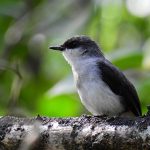MANGROVE ROBIN
Sharon: I have only ever seen the elusive Mangrove Robins a couple of times in the Mangroves near Cairns Esplanade in North Queensland, Australia. On each occasion he was singing away quite happily. I didn’t expect such a beautiful song. Have a listen
The Mangrove robin is a unique bird that calls the dense mangrove forests of Australia its home. This small, yet captivating creature is a study in adaptation and resilience, thriving in an environment that is as challenging as it is vital to the coastal ecosystem.
Imagine wandering through a mangrove forest, the air thick with humidity and the unmistakable scent of saltwater mingling with earth. The twisted roots of the mangroves form an intricate lattice that seems to float above the water, creating a natural labyrinth. It’s here, among the shadowy greenery and dappled sunlight, that the Mangrove robin makes its presence known.
With its modest plumage, the Mangrove robin may not appear as flamboyant as some of its avian counterparts. Its feathers are a mix of dusky greys and subtle browns, with a lighter belly – a perfect camouflage against the backdrop of bark and shadows. But don’t let its understated appearance fool you; this bird is a master of its domain.
The Mangrove robin’s song is a delightful melody, a series of clear, whistled notes that echo through the stillness of its habitat. This call serves as a beacon to others of its kind, a way to communicate amidst the dense foliage. Birdwatchers keen to spot this elusive species must rely on patience and a keen ear, for the Mangrove robin is often heard long before it is seen.
In terms of behaviour, the Mangrove robin is a ground feeder, scouring the muddy earth and underbrush for insects and small invertebrates. Its diet is a testament to the rich biodiversity found within the mangrove ecosystem. The bird’s foraging habits also play a crucial role in the health of the mangroves, as it helps to control insect populations and contributes to the nutrient cycle.
The Mangrove robin’s breeding habits are similarly intertwined with its environment. It builds its nest low in the mangrove trees, using twigs and leaves to craft a sturdy, cup-shaped cradle for its eggs. The choice of nesting site is strategic, offering protection from predators and tidal fluctuations.
Sadly, like many species dependent on specific habitats, the Mangrove robin faces threats from environmental changes. The degradation of mangrove forests due to coastal development, pollution, and climate change-related impacts such as rising sea levels, poses significant challenges to the survival of this species.
To ensure the future of the Mangrove robin, conservation efforts focus on protecting and restoring mangrove forests. These actions not only safeguard the bird but also reinforce the health of the entire coastal ecosystem, which benefits countless other species, including humans.
The story of the Mangrove robin is a poignant reminder of the intricate connections within nature and the importance of preserving the delicate balance that sustains life. It’s a call to action, encouraging us to appreciate and protect the natural wonders that are an essential part of our world’s biodiversity.





